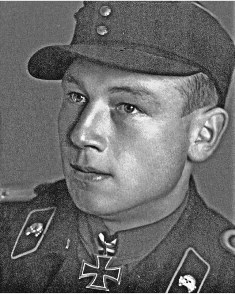Bunzel, Hans-Karl
- Date of birth:
- October 28th, 1918 (Haynau (Silesia), Germany)
- Date of death:
- November 12th, 1995 (Neukirchen bei Heiligenblut (Bavaria), Germany)
- Nationality:
- German
Biography
On the 17.12.1944 Bunzel destroyed his 55th tank, and by this time he had participated in over 100 armoured engagements. According to his own claims he had destroyed 95 enemy tanks by war’s end.
00.02.1943: Oberfeldwebel
00.07.1943: Leutnant
00.02.1943: Zugführer, 3./ Panzer-Abteilung 116
00.07.1943: Stabskompanie/ Panzer-Abteilung 116
00.11.1944: 3./ Panzer-Regiment 16
Do you have more information about this person? Inform us!
- Period:
- Second World War (1939-1945)
- Awarded on:
- September 19th, 1940
- Period:
- Second World War (1939-1945)
- Awarded on:
- July 21st, 1941
- Period:
- Second World War (1939-1945)
- Rank:
- Oberfeldwebel (Warrant Officer)
- Unit:
- Zugführe, 3. Kompanie, Panzer-Abteilung 116, 16.Infanterie-Division, 4.Panzerarmee, Heeresgruppe Don
- Awarded on:
- February 10th, 1943
“The Führer has awarded the Knight’s Cross of the Iron Cross to Oberfeldwebel Hans Bunzel of the 3./Panzer-Abteilung 116.
On the 14.01.1943 the Division received the mission of breaking out from the Proletarskaja bridgehead towards the west, marching through the enemy to take the Manytsch dam at Spornyj, opening up the path over the dam and creating a bridgehead at Spornyj. Following a short yet fierce fight the flank security units of the Russian 5th Motorized Brigade were overwhelmed and destroyed near Bolotoff. Advancing swiftly, the Division secured the enemy-free area around Limanskij and took up a hedgehog position there during the night. Then, on the morning of the 15.01.1943, it set out once again for the decisive thrust towards Spornyj. Every man knew how important this was, as by now the first enemy tanks had already begun probing the Division’s rearguard along its march road from the east and northeast. Spornyj had to be taken as soon as possible, or else the Division would be in danger of encirclement.
Oberfeldwebel Bunzel led the armoured spearhead. He drove swiftly forwards through several villages that were clear of the enemy. He carefully approached the village of Spornyj (which covered the important dam with the bridge). Wild defensive fire erupted from an enemy that was clearly prepared. Clearly grasping the situation, Bunzel turned with his Panzers and drove straight towards the dam under strong flanking fire. Moving far ahead of the by now dismounted infantry that were meanwhile starting their own attack, he stormed both the dam and the bridge position, thereby being the first to bring this important attack objective into our hands. From here he then thrust into the village itself, again far ahead of our own infantry. He destroyed one enemy tank, drove out a second, captured a third, overran an entire battery of 7.62 cm guns and cleared the way for our infantry with exceptional attacking spirit. The enemy, now cut off from their retreat route, defended bitterly. 140 enemy dead were later counted in the village, while 12 anti-tank rifles and numerous MGs were knocked out.
The Russians had not counted on the impetuous daredevilry of Oberfeldwebel Bunzel and his Panzers. The battle was over in a relatively short time, and its conclusion was decisive for the whole Division in determining whether it would be presented with a great victory or serious danger. It fell into the former category, thanks to the bold attack of the Panzer Zugführer Oberfeldwebel Bunzel.
This was the first operation of this extremely brave and proven fighter following his return to the unit after recovering from his 4th wound.
The Division wishes its young Knight’s Cross Holder the best of luck. We are proud of him. The Division is also quite proud of its Panzer-Abteilung as a whole. Its tireless and unfailing efforts have mastered numerous dangerous situations. It has dealt with great dangers for the Grenadier-Regiments and cracked many hard nuts (i.e. enemy tanks).
We are all glad of the fact that the Panzer-Abteilung has been justly recognized by the bestowal of this high honour to one of its members, namely Oberfeldwebel Bunzel.”
Submitted on February 6th 1943.
Preliminary document and decoration on February 14th 1943 to Pz.AOK 4.
- Period:
- Second World War (1939-1945)
- Rank:
- Oberleutnant (1st Lieutenant)
- Unit:
- 3. Kompanie, Panzer-Regiment 16
- Awarded on:
- November 6th, 1944
- Period:
- Second World War (1939-1945)
- Rank:
- Oberleutnant (1st Lieutenant)
- Unit:
- Stabskompanie, Panzer-Abteilung 116
- Awarded on:
- July 2nd, 1943
- Period:
- Second World War (1939-1945)
- Rank:
- Leutnant (2nd Lieutenant)
- Unit:
- 3. Kompanie, I. Abteilung, Panzer-Regiment 16, 116. Panzer-Division, Heer
- Awarded on:
- February 8th, 1945
- Period:
- Second World War (1939-1945)
- Awarded on:
- August 10th, 1941
- Period:
- Second World War (1939-1945)
- Awarded on:
- September 18th, 1941
- Period:
- Second World War (1939-1945)
- Awarded on:
- August 22nd, 1942
- Period:
- Second World War (1939-1945)
- Awarded on:
- December 4th, 1943
- Period:
- Second World War (1939-1945)
- Awarded on:
- August 10th, 1942
- Period:
- Second World War (1939-1945)
Sources
- Photo 1:
- - FELLGIEBEL, W.P., Elite of theThird Reich, Helion & Company Limited, Solihull, 2003.
- WEGMANN, GüNTER, Die Ritterkreuzträger der Deutschen Wehrmacht 1939-1945, Biblio-Verlag, 2004.
- Die Ordensträger der Deutschen Wehrmacht (CD), VMD-Verlag GmbH, Osnabrück, 2002
- Federl, C., Die Ritterkreuzträger der Deutschen Panzerdivisionen 1939-1945, VDM Heinz Nickel, Zweibrücken, Germany, 2000
- Scheibert, Horst. Die Träger des Deutschen Kreuzes in Gold (Das Heer). Podzun-Pallas Verlag, Friedberg, Germany, 1983, ISBN 3-7909-0207-1
- Onderzoek via Panzer-Archiv Forum
- Die Träger des Deutschen Kreuzes














